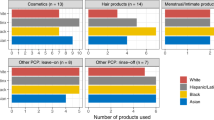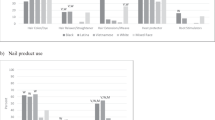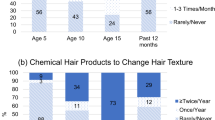Abstract
Despite daily exposure to chemicals in cosmetic products, there are few studies on the exposure levels to cosmetics particularly in Asians. We sought to investigate the usage pattern of cosmetics, including eye makeup products, fragrances, color makeups, and hair and nail care products, in Koreans. An online survey of 1,800 participants (908 males and 892 females, aged 15–59 years) from 5 Metropolitan cities (Seoul, Incheon, Daejeon, Daegu, and Busan) in Korea was conducted. For overall types of cosmetics, the proportion of users was 7.1% (range: 0.0–46.3%) in males and 30.7% (range: 1.0–82.8%) in females. The most prevalently used product was perfume (46.3%) in males and lipstick (82.8%) in females. In addition, the mean number of application for overall types of cosmetics was 22.7 (range: 4.6–49.4) times per month in male users and 24.8 (range: 4.2–62.0) in female users. The usage pattern was significantly altered according to demographic and socioeconomic factors, including age group, occupation, and income. This work estimated the prevalences and frequencies of use of a wide collection of cosmetics from a large number of Koreans and found that the usage pattern was significantly associated with demographic and socioeconomic factors.
This is a preview of subscription content, access via your institution
Access options
Subscribe to this journal
Receive 6 print issues and online access
$259.00 per year
only $43.17 per issue
Buy this article
- Purchase on Springer Link
- Instant access to full article PDF
Prices may be subject to local taxes which are calculated during checkout




Similar content being viewed by others
References
Li D, Wu Z, Martini N, Wen J . Advanced carrier systems in cosmetics and cosmeceuticals: a review. J Cosmet Sci 2011; 62: 549–563.
Bao J, Wang M, Ning X, Zhou Y, He Y, Yang J et al. Phthalate concentrations in personal care products and the cumulative exposure to female adults and infants in Shanghai. J Toxicol Environ Health A 2015; 78: 325–341.
Nduka JK, Odiba, Orisakwe OE, Ukaebgu LD, Sokaibe C, Udowelle NA . Human health risk assessment of heavy metals in cosmetics in Nigeria. J Cosmet Sci 2015; 66: 233–246.
Warheit DB, Donner EM . Risk assessment strategies for nanoscale and fine-sized titanium dioxide particles: recognizing hazard and exposure issues. Food Chem Toxicol 2015; 85: 138–147.
Yueh MF, Tukey RH . Triclosan: a widespread environmental toxicant with many biological effects. Annu Rev Pharmacol Toxicol 2016; 56: 251–272.
Loretz L, Api AM, Barraj L, Burdick J, Davis de A, Dressler W et al. Exposure data for personal care products: hairspray, spray perfume, liquid foundation, shampoo, body wash, and solid antiperspirant. Food Chem Toxicol 2006; 44: 2008–2018.
Loretz LJ, Api AM, Babcock L, Barraj LM, Burdick J, Cater KC et al. Exposure data for cosmetic products: facial cleanser, hair conditioner, and eye shadow. Food Chem Toxicol 2008; 46: 1516–1524.
Loretz LJ, Api AM, Barraj LM, Burdick J, Dressler WE, Gettings SD et al. Exposure data for cosmetic products: lipstick, body lotion, and face cream. Food Chem Toxicol 2005; 43: 279–291.
Wu XM, Bennett DH, Ritz B, Cassady DL, Lee K, Hertz-Picciotto I . Usage pattern of personal care products in California households. Food Chem Toxicol 2010; 48: 3109–3119.
Biesterbos JW, Dudzina T, Delmaar CJ, Bakker MI, Russel FG, von Goetz N et al. Usage patterns of personal care products: important factors for exposure assessment. Food Chem Toxicol 2013; 55: 8–17.
Hall B, Steiling W, Safford B, Coroama M, Tozer S, Firmani C et al. European consumer exposure to cosmetic products, a framework for conducting population exposure assessments Part 2. Food Chem Toxicol 2011; 49: 408–422.
Hall B, Tozer S, Safford B, Coroama M, Steiling W, Leneveu-Duchemin MC et al. European consumer exposure to cosmetic products, a framework for conducting population exposure assessments. Food Chem Toxicol 2007; 45: 2097–2108.
Manova E, von Goetz N, Keller C, Siegrist M, Hungerbuhler K . Use patterns of leave-on personal care products among Swiss-German children, adolescents, and adults. Int J Environ Res Public Health 2013; 10: 2778–2798.
Rawlings AV . Ethnic skin types: are there differences in skin structure and function? Int J Cosmet Sci 2006; 28: 79–93.
Fuyuno I . Spotlight turns on cosmetics for Asian skin. Nature 2004; 432: 938.
Kim S, Yi S, Kim M, Kim B, Lee H, Jeon T et al. Unequal geographic distribution of life expectancy in Seoul. Asia Pac J Public Health 2015; 27: NP1002–NP1012.
Kim SJ, Choi SB . Cultural taste of Seoul Gangnam and Gangbuk viewed via cultural lessons - focusing on the cultural lessons in department store culture center and community centers-. Rev Cult Econ 2012; 15: 3–29.
Rhee C, Kwon T . Income difference of wage workers among northern and southern districts in Seoul: the case of employment and wage structures. J Korean Natl Econ 2005; 23: 125–143.
Korean Internet & Security Agency 2015 Survey on the internet usage. Korean Internet & Security Agency, 2015, Available from http://isis.kisa.or.kr/board/?pageId=060100&bbsId=7&itemId=813&pageIndex=1. Accessed 31 July 2016.
Statistics Korea. Population statistics based on resident registration. Korean Statistical Information Service. Available from http://kosis.kr/statisticsList/statisticsList_01List.jsp?vwcd=MT_ZTITLE&parentId=A#SubCont. Accessed 31 July 2016.
Acknowledgements
This research was supported by a grant (14172MFDS975) from the Ministry of Food and Drug Safety of Korea and conducted with online research companies, Macromill Embrain Company and IEC Korea Company. We thank all of our respondents for their participation.
Author information
Authors and Affiliations
Corresponding author
Ethics declarations
Competing interests
The authors declare no conflict of interest.
Additional information
Supplementary Information accompanies the paper on the Journal of Exposure Science and Environmental Epidemiology website
Supplementary information
Rights and permissions
About this article
Cite this article
Park, GH., Nam, C., Hong, S. et al. Socioeconomic factors influencing cosmetic usage patterns. J Expo Sci Environ Epidemiol 28, 242–250 (2018). https://doi.org/10.1038/jes.2017.20
Received:
Accepted:
Published:
Issue Date:
DOI: https://doi.org/10.1038/jes.2017.20
Keywords
This article is cited by
-
Contamination and Carcinogenic Risks of Lead in Lip Cosmetics in China
Bulletin of Environmental Contamination and Toxicology (2024)
-
Patterns of household and personal care product use by the Korean population: implications for aggregate human exposure and health risk
Environmental Sciences Europe (2020)



